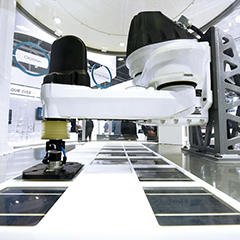Pforzheim, October 27, 2020 – The rising demand for photovoltaics, technological innovations and decreasing costs are making the manufacture of photovoltaic products in Europe attractive. This trend is further boosted by the research and mechanical engineering expertise represented on the continent as well as problems with global supply chains induced by the coronavirus pandemic. Despite the still tangible effects of the corona pandemic, European companies such as Meyer Burger and NexWafe are setting up new production facilities in Europe. Intersolar Europe, the world’s leading exhibition for the solar industry, will once again dedicate an exhibition space to PV production technologies in 2021. The exhibition will take place as part of The smarter E Europe at Messe München from June 9–11, 2021.
In view of a drop in order intakes suffered by PV mechanical engineer in the second quarter of 2020 and an expected global drop of installations by four percent to 112 Gigawatts (GW) in the year 2020, SolarPower Europe’s Global Market Outlook (GMO) 2020-2024 predicts growth of up to 34 percent for the coming year. And the current coronavirus pandemic is not expected to change this: “Photovoltaics is often more cost-efficient than other power generation technologies – a trend that is accelerating with time since the costs of solar power generation are still dropping faster than those of other technologies,” says Michael Schmela, Executive Advisor, Head of Market Intelligence & Member of the Leadership Team at SolarPower Europe. It is predicted that newly installed photovoltaic capacity in Europe will reach at least 30 gigawatts each year between now and 2023. Government programs promoting sustainability such as the European Green Deal and the EU Recovery Package are helping this trend along.
Innovation drives development
Innovations in the module, cell and wafer segments in particular are also helping drive this market development. This can be seen in the trajectory of solar module development – from multi-busbar technology to half-cut cell modules to solar tiles and shingles. Meanwhile, both module wattage and wafer size have increased over time. The next step toward even greater efficiency is heterojunction technology, which boasts cell efficiencies of over 25 percent; this technology earned REC Solar EMEA GmbH the Intersolar Award this year.
Product innovations and optimizations, rising demand and sinking production costs are enabling solar companies to bring photovoltaic production back to Europe. Initiatives and collaborations such as the Solar Manufacturing Accelerator scheme aim to re-establish and advance PV production in Europe. “Europe is an attractive production site because production is environmentally friendly and profitable here and has proven feasible even without subsidies,” explains Dr. Jutta Trube, Vice Managing Director of Electronics, Micro and New Energy Production Technologies (EMINT) at the German Mechanical Engineering Industry Association (VDMA).



























